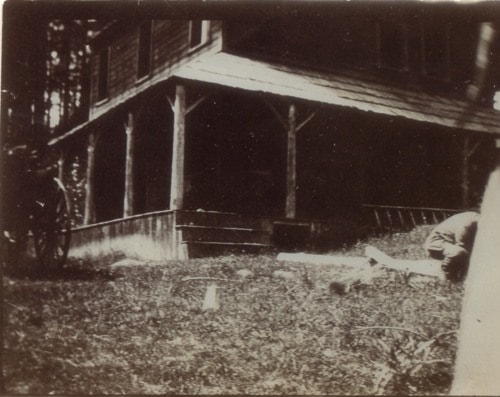One fine afternoon in September 1971 Trevor Green, at the urging of one of his children, drove down to the “halfway crossing” on the old Lake Cowichan Highway to see what, if anything, could be found of the former Halfway House.
Although Trevor was certain that not a trace of the old building remained let alone a cache of ancient but valuable bottles — which, rumor had it, were buried there 60 years prior — near the old halfway house. From the crossing, the two made their way along the railway track “as instructed by Charlie March” (of the March pioneer family). In a few minutes they located a spot that Trevor presumed to have once been the location of the old halfway house. This was long before the advent of halfway-houses used for wayward souls or newly released prisoners.
The halfway house had been erected many decades before as a rest stop for stagecoach drivers and their tired and thirsty horses [and other travelers]. Situated about halfway along the trail (road) that connected Cowichan Lake with Duncan, it had regularly been used by early area pioneer Frank Green during his twice weekly trips to and from Duncan. While his horses rested he and any passengers who may have been riding with him, would enjoy a cup of tea brewed by Frank while resting momentarily at the halfway house.
On occasion, Frank’s wife Louie (Louisa Green) would walk the 10 miles, with only their old dog for company, from the family home at Greendale through the “majestic forests of towering conifers.”There she met-up with her husband at the halfway house and presumably rode home with him. The stopping place, as recalled by Trevor, was located near a small stream of clear cold water which was the water source for the horses and the tea.
Inside the halfway house was an axe, an old stove, a few dishes and pans. There was always a supply of kindling, firewood and dry newspaper available for use by the next arrivals which was expected to be replaced. In the winter of 1916, the building that had given so many a safe haven from inclement weather and tiredness, collapsed under the “colossal” weight of snow “burying beneath it an unfortunate man who had sought overnight shelter on his way to Duncan.”
Trevor and his child “poked around” beneath brush and debris with their pitchforks. Finding nothing but a rotting section of timber that once was a part of the halfway house. There was a large nail embedded in it that was half eaten away by rust! All hopes were dashed that the hoped-for cache of valuable bottles would be found. The pair continued their exploration further down the railway tracks until they reached their “well loved Walden Pond.”
Walking back along the railway track they reached the site of the old [railway] station house, which by then, had long vanished. Nearby, among a few scraggy apple trees (which provided clues to the location), they “came upon a midden” (garbage mound) consisting of piles of rusty tin cans, a broken piece of crockery and a few scattered bottles but nothing of any value to a bottle collector.
Although there was nothing valuable found, the expedition had evoked Trevor’s memory of days long past. Days of the halfway house and the station house; both lost to time.
Information source is with permission from Greendale Journals
